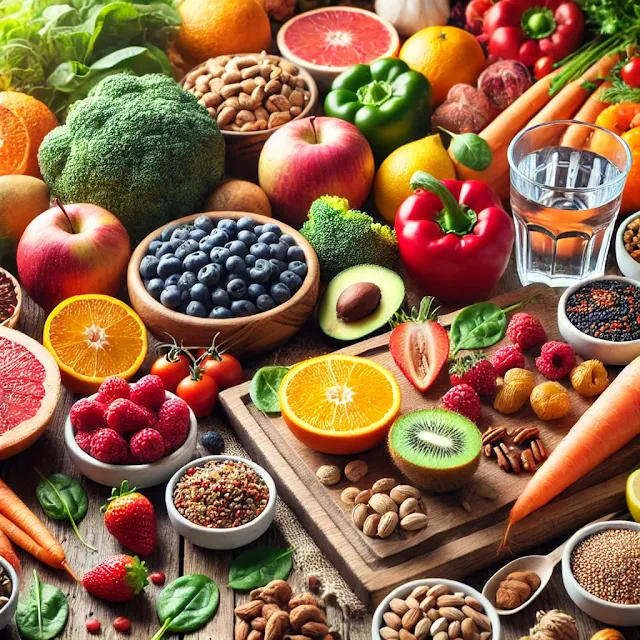Introduction
Cancer is one of the leading causes of death globally, affecting millions of lives every year. While some factors, such as genetics, are beyond our control, research shows that lifestyle choices play a significant role in reducing cancer risk. By adopting healthy habits and taking proactive measures, you can significantly protect yourself from developing cancer. This guide provides a comprehensive, step-by-step approach to cancer prevention, based on scientific evidence.
Step 1: Understand the Risk Factors
The first step in protecting yourself from cancer is understanding its risk factors. Cancer occurs when cells in the body grow uncontrollably, and this process is influenced by a combination of genetic, environmental, and lifestyle factors.
Key Risk Factors
1. Genetics: Family history of cancer increases risk, but it doesn't guarantee you will develop the disease.
2. Lifestyle Choices: Tobacco use, poor diet, lack of exercise, and excessive alcohol consumption are major contributors.
3. Environmental Exposures: Exposure to carcinogens such as ultraviolet (UV) rays, asbestos, and pollution.
4. Infections: Certain viruses, like human papillomavirus (HPV) and hepatitis B/C, can increase cancer risk.
Understanding these factors allows you to make informed decisions about your health.
Step 2: Quit Smoking and Avoid Tobacco
Tobacco use is the leading cause of preventable cancer deaths worldwide. It is linked to various cancers, including lung, throat, mouth, and bladder cancer.
How to Quit Smoking
Set a Quit Date: Commit to a specific day to stop smoking.
Seek Support: Join support groups, use counseling services, or involve family and friends.
Use Smoking Cessation Tools: Consider nicotine replacement therapy (NRT) or prescription medications.
Avoid Triggers: Identify and avoid situations or habits that make you want to smoke.
If you're not a smoker, avoid exposure to secondhand smoke, which can also increase cancer risk.
Step 3: Eat a Balanced, Cancer-Fighting Diet
Your diet plays a crucial role in cancer prevention. Consuming nutrient-rich foods can strengthen your immune system and lower the risk of developing cancer.
Cancer-Fighting Foods
1. Fruits and Vegetables: Rich in antioxidants, vitamins, and fiber. Focus on dark leafy greens, berries, carrots, and citrus fruits.
2. Whole Grains: Brown rice, quinoa, and whole wheat provide essential nutrients and help maintain a healthy weight.
3. Healthy Fats: Include sources of omega-3 fatty acids like salmon, walnuts, and flaxseeds.
4. Herbs and Spices: Turmeric, garlic, and ginger have anti-inflammatory and anticancer properties.
Foods to Avoid
Processed meats (e.g., bacon, sausages).
Sugary drinks and snacks.
Excessive red meat.
Trans fats and fried foods.
Step 4: Maintain a Healthy Weight
Obesity is linked to several cancers, including breast, colon, and kidney cancer. Excess body fat can lead to chronic inflammation and hormonal imbalances, which increase cancer risk.
Steps to Maintain a Healthy Weight
Monitor Your BMI: Aim for a body mass index (BMI) between 18.5 and 24.9.
Exercise Regularly: Engage in at least 150 minutes of moderate aerobic activity or 75 minutes of vigorous activity per week.
Portion Control: Eat smaller portions to avoid overeating.
Hydration: Drink plenty of water to support metabolism and reduce unnecessary calorie intake.
Step 5: Exercise Regularly
Physical activity reduces the risk of several cancers, including colon, breast, and endometrial cancer. Exercise helps regulate hormones, improve immunity, and maintain a healthy weight.
Types of Exercises
1. Cardiovascular Activities: Walking, jogging, cycling, or swimming.
2. Strength Training: Build muscle and improve metabolism through weightlifting or resistance exercises.
3. Flexibility Exercises: Yoga or stretching to reduce stress and improve overall well-being.
Find an activity you enjoy to ensure consistency.
Step 6: Limit Alcohol Consumption
Excessive alcohol intake is associated with cancers of the mouth, throat, esophagus, liver, and breast. Alcohol can damage DNA and impair the body's ability to process harmful toxins.
Recommended Limits
Women: No more than one drink per day.
Men: No more than two drinks per day.
If you don't drink, there's no need to start for health reasons.
Step 7: Protect Your Skin from UV Rays
Skin cancer, including melanoma, is primarily caused by exposure to UV radiation from the sun or tanning beds. Protecting your skin is essential for cancer prevention.
Tips for Sun Safety
1. Use Sunscreen: Apply broad-spectrum sunscreen with an SPF of at least 30, even on cloudy days.
2. Wear Protective Clothing: Hats, sunglasses, and long-sleeved shirts can shield your skin.
3. Avoid Peak Sun Hours: Stay indoors between 10 a.m. and 4 p.m. when the sun's rays are strongest.
4. Avoid Tanning Beds: These emit harmful UV radiation that can increase your risk of skin cancer.
Step 8: Get Vaccinated
Certain vaccines can protect against infections that increase cancer risk.
Key Vaccinations
HPV Vaccine: Protects against cervical, anal, and other HPV-related cancers.
Hepatitis B Vaccine: Reduces the risk of liver cancer caused by hepatitis B infection.
Speak with your doctor about recommended vaccines for your age and health status.
Step 9: Stay Informed About Environmental Hazards
Exposure to harmful substances in your environment can increase cancer risk. Being aware of and reducing exposure to these hazards is crucial.
Tips to Reduce Exposure
Test your home for radon, a radioactive gas linked to lung cancer.
Avoid using products with asbestos, commonly found in older buildings.
Use protective equipment if you work with chemicals or hazardous materials.
Limit exposure to air pollution by avoiding outdoor activities on days with high pollution levels.
Step 10: Manage Stress and Mental Health
Chronic stress and poor mental health can weaken the immune system, making it harder for your body to fight off cancerous changes.
Stress-Management Techniques
Meditation: Practice mindfulness or deep breathing exercises.
Hobbies: Engage in activities you enjoy to relax and recharge.
Social Connections: Spend time with loved ones for emotional support.
Professional Help: Seek therapy or counseling if needed.
Step 11: Get Regular Screenings
Early detection is key to successfully treating many cancers. Regular screenings can identify precancerous changes or cancer in its early stages.
Recommended Screenings
1. Breast Cancer: Mammograms starting at age 40 or earlier for high-risk individuals.
2. Colorectal Cancer: Colonoscopy or stool tests starting at age 45.
3. Cervical Cancer: Pap smears and HPV tests for women aged 21-65.
4. Prostate Cancer: PSA tests for men, especially those over 50.
5. Skin Cancer: Regular skin checks for unusual moles or spots.
Discuss your personal risk factors with your doctor to determine the appropriate screening schedule.
Step 12: Stay Educated and Advocate for Your Health
Cancer research is constantly evolving, and staying informed about new findings can help you make better health choices.
How to Stay Informed
Follow reputable health organizations like the World Health Organization (WHO) or American Cancer Society.
Read up-to-date, evidence-based articles.
Attend health seminars or workshops in your community.
Be proactive in discussing any concerns with your healthcare provider and advocating for your health needs.
Conclusion
Protecting yourself from cancer requires a multi-faceted approach that combines healthy lifestyle choices, regular medical care, and awareness. By following this step-by-step guide, you can significantly reduce your risk of developing cancer and improve your overall quality of life. Remember, the journey to cancer prevention starts with small, consistent steps. Take action today to safeguard your future health.



